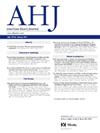Towards a person-centered after-visit summary to facilitate improved heart failure care (HF-AVS): A scoping review and call to action
IF 3.7
2区 医学
Q1 CARDIAC & CARDIOVASCULAR SYSTEMS
引用次数: 0
Abstract
Person-centered care (PCC) has been advanced as an optimal model for chronic heart failure management in multiple guidelines. However, fulfilling the ideal of this model requires overcoming healthcare fragmentation via effective provider-to-patient communication. One potential communication tool is the after-visit summary (AVS), a core feature of modern electronic health records (EHR); however, little is known regarding its quality from a PCC lens and whether an optimal AVS for the heart failure (HF) population has been created previously. We evaluate the history of AVS use in U.S. healthcare as well as map the extent and type of evidence on its quality, stakeholder perspectives, and attempts to perform PCC-related modifications across various healthcare settings as well as in acute-on-chronic or chronic HF specifically, evaluating if a HF-specific AVS (HF-AVS) has been reported. A search of the peer-reviewed literature was conducted of MEDLINE (via Pubmed) and SCOPUS. Select gray literature was included if cited by peer-reviewed articles. Articles were included if they were: 1) written in English, 2) discussed an EHR-generated documented intended for provider-to-patient communication, and 3) were situated within the U.S. healthcare system. Two authors screened relevant articles, with disagreements resolved by consensus. If a resolution was not found the senior author broke ties. Data were extracted by 1 abstractor and checked by at least 1 additional abstractor. This scoping review found that the AVS became a part of the modern electronic health record via legislative action. Incentives for continued use are still in place. While AVS use is widespread its quality is poor, without the necessary readability for PCC models. Patient, provider, and care partner perspectives suggest the need to reduce medical jargon and streamline workflows; however, barriers exist at the level of EHR vendors, preventing large PCC modifications. In contrast, small “embeddable” interventions appear more likely to be successful. No HF-AVS was identified; however, the modification of an existing patient-oriented discharge summary for heart failure (PODS-HF) was present, warranting exploration of embedding the document into EHRs. One potential HF specific “embeddable” intervention is free text prompting patient initiation and up titration of guideline-directed medical therapy and routing to HF nursing and pharmacist teams. If pursued, teams should secure funding, collaborate with EHR vendors, and trial these interventions with objective medication and/or exercise adherence. Limitations to this scoping review are present including the lack of a preregistered protocol. Future work is needed to increase the quality of the AVS evidence base.
以人为中心的访后总结促进改善心力衰竭护理(HF-AVS):范围回顾和行动呼吁。
以人为本的护理(PCC)已作为慢性心力衰竭管理的最佳模式在多个指南中得到推广。然而,要实现这一模式的理想,需要通过医疗服务提供者与患者之间的有效沟通来克服医疗服务的分散性。就诊后摘要(AVS)是一种潜在的沟通工具,也是现代电子健康记录(EHR)的核心功能之一;然而,从慢性心力衰竭管理的角度来看,人们对其质量知之甚少,也不知道以前是否为心力衰竭(HF)人群设计过最佳的就诊后摘要。我们评估了 AVS 在美国医疗保健中的使用历史,并绘制了有关其质量的证据范围和类型、利益相关者的观点以及在各种医疗保健环境中进行 PCC 相关修改的尝试,特别是在急性慢性心力衰竭或慢性心力衰竭中,评估了是否有专门针对心力衰竭的 AVS(HF-AVS)的报道。通过 MEDLINE (Pubmed) 和 SCOPUS 对同行评审文献进行了检索。如果同行评议文章引用了部分灰色文献,则将其包括在内。如果文章是1)用英语撰写;2)讨论了电子病历生成的用于医疗服务提供者与患者交流的文档;3)位于美国医疗保健系统内。两位作者对相关文章进行筛选,有分歧时通过协商一致的方式解决。如果无法达成一致,则由资深作者打破僵局。数据由一名文摘员提取,并由至少另一名文摘员检查。此次范围界定审查发现,通过立法行动,AVS 已成为现代电子病历的一部分。继续使用的激励措施仍在实施。虽然 AVS 的使用很普遍,但其质量很差,不具备 PCC 模型所需的可读性。从患者、医疗服务提供者和护理合作伙伴的角度来看,有必要减少医疗术语,简化工作流程;然而,电子病历供应商存在障碍,无法对 PCC 进行大规模修改。相比之下,小型的 "可嵌入式 "干预措施似乎更有可能取得成功。目前还没有发现高频自适应医疗系统;但对现有的以患者为导向的心衰出院摘要(PODS-HF)进行了修改,因此有必要探讨将该文档嵌入电子病历的问题。一种潜在的针对心力衰竭的 "可嵌入 "干预措施是通过自由文本提示患者开始和增加指南指导下的药物治疗,并将其发送给心力衰竭护理团队和药剂师团队。如果要进行干预,团队应确保资金来源,与 EHR 供应商合作,并通过客观的药物和/或运动依从性对这些干预措施进行试验。本范围界定综述存在局限性,包括缺乏预先登记的协议。今后还需开展工作,提高 AVS 证据库的质量。
本文章由计算机程序翻译,如有差异,请以英文原文为准。
求助全文
约1分钟内获得全文
求助全文
来源期刊

American heart journal
医学-心血管系统
CiteScore
8.20
自引率
2.10%
发文量
214
审稿时长
38 days
期刊介绍:
The American Heart Journal will consider for publication suitable articles on topics pertaining to the broad discipline of cardiovascular disease. Our goal is to provide the reader primary investigation, scholarly review, and opinion concerning the practice of cardiovascular medicine. We especially encourage submission of 3 types of reports that are not frequently seen in cardiovascular journals: negative clinical studies, reports on study designs, and studies involving the organization of medical care. The Journal does not accept individual case reports or original articles involving bench laboratory or animal research.
 求助内容:
求助内容: 应助结果提醒方式:
应助结果提醒方式:


